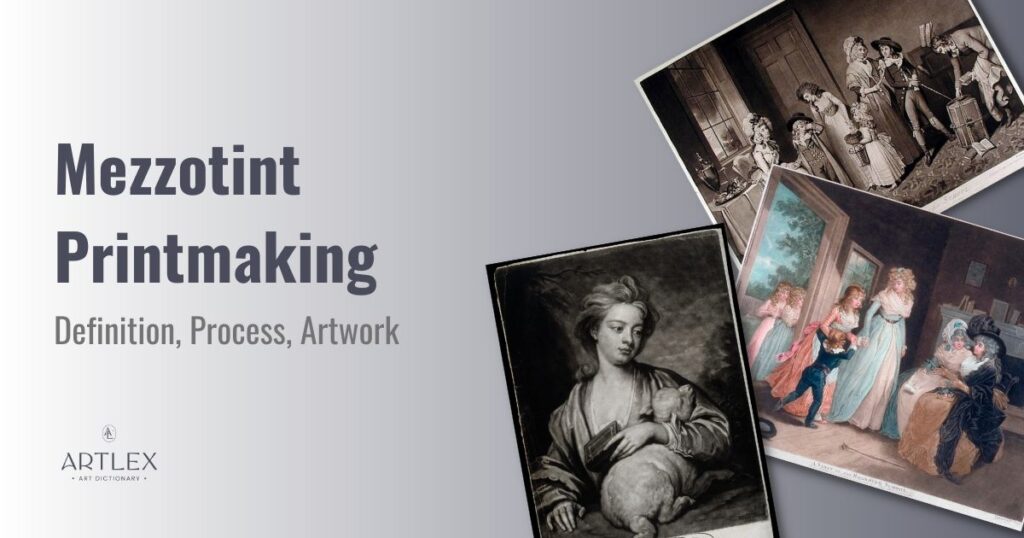
Mezzotint or “mezzo-tinto” is a printmaking technique developed in the seventeenth century that uses a tool to create a coarse surface on a metal plate, which is then inked and printed.
The engraving begins by creating a uniform texture on a metal plate by evenly and systematically “rocking” a tool called a rocker over the plate.
Areas of the plate that have been rubbed show up as lighter areas when inked and printed, while those left untouched show up darker. This method allows for subtle gradations and fine details in print.
Examples of artwork and artists that use mezzotint include Prince Rupert of the Rhine’s “The Great Executioner with the Head of Saint John the Baptist” (1658), located at New York’s Metropolitan Museum of Art; John Raphael Smith’s “Lieutenant-Colonel Banastre Tarleton” (1782); and Peter Ilsted’s “Sunshine Falling on a Door” (1910). Contemporary artists such as Jukka Vänttinen and Carol Wax also use the method.
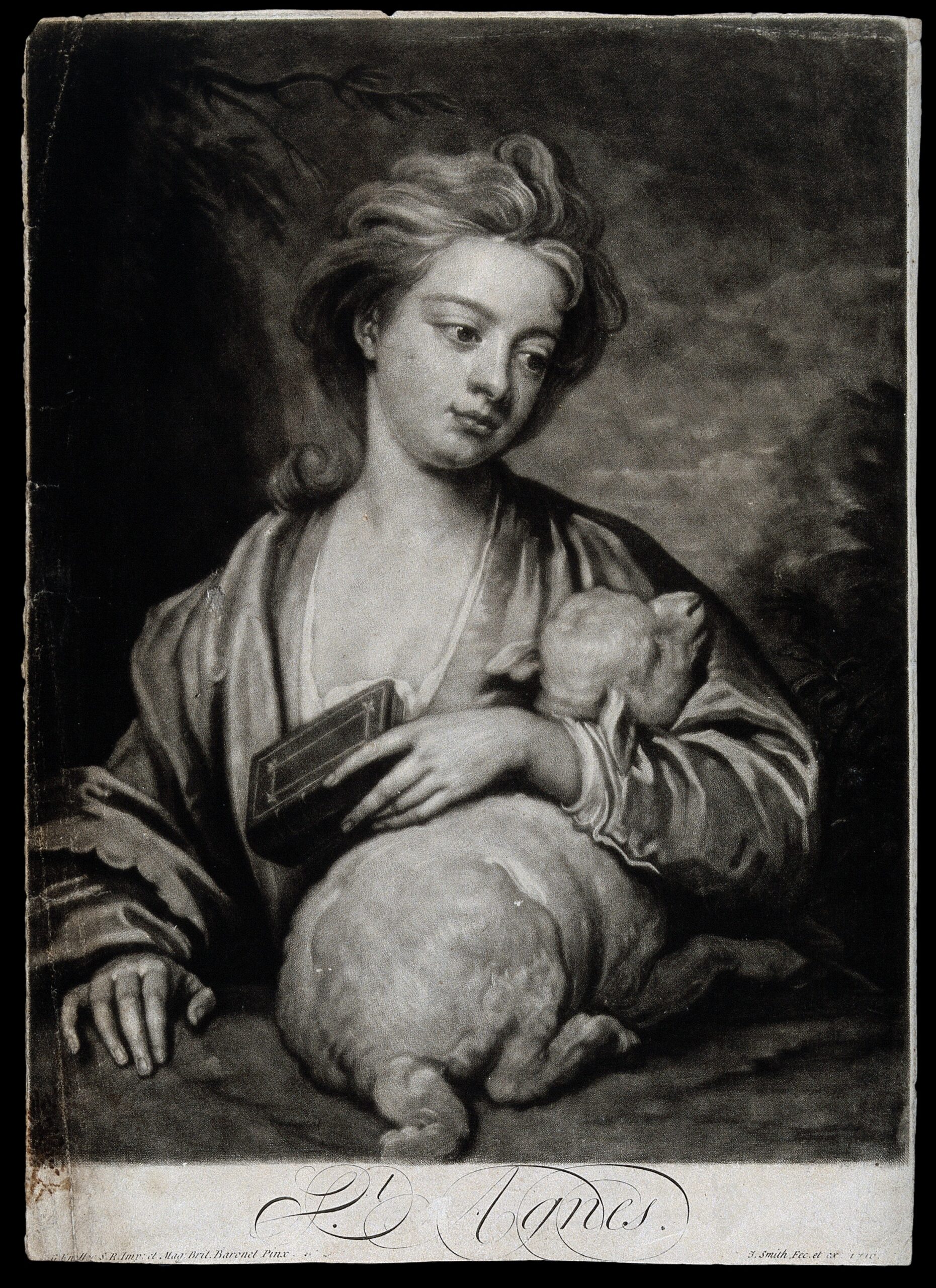
Mezzotint Definition
Mezzotint, also known as “mezzo-tinto,” which means “half-tone” in Italian, is a form of intaglio printmaking developed in the seventeenth century. The technique involves creating a coarse surface on a metal plate, typically copper, by repeatedly rocking a specialized tool called a “rocker” over the plate.
The rocking motion of the rocker pushes small burrs into the surface of the plate, creating a uniform texture that holds ink.
The engraving is subtractive, meaning that the artist starts with a plate that is rough and then polishes parts of it to make the image they want. This technique is the opposite of an additive method, such as etching, where the artist starts with a smooth plate and then makes the image by cutting lines into the copper plate.
Mezzotint History
Mezzotint is a printmaking technique with a rich history dating back to the seventeenth century. It was made by a German artist named Ludwig von Siegen, and European artists and printmakers quickly took to it.
It was prevalent in the eighteenth and nineteenth centuries when mezzotint engravers used it to create portraits, landscapes, and other types of prints. With the rise of photography and other printmaking methods at the beginning of the 20th century, the technique fell out of use. However, it has come back recently as artists rediscover its unique qualities.
Mezzotint History: Invention of Mezzotint
Ludwig von Siegen, born in Germany, was a seventeenth-century drawing master and professional engraver searching for a way to create images with the same tonal range as paintings. He discovered that by creating a rough surface on a copper plate, he could make prints with a wide range of tones, from solid black to light grey.
Siegen’s process was a significant breakthrough in printmaking, as it allowed for the creation of prints with a much greater range of tonal values than was possible with other printmaking techniques of the time, such as engraving and etching. This allowed the creation of highly detailed, realistic images that were almost indistinguishable from paintings.
Dutch printmakers took note of the printmaking technique as well, like Jan van Somer, Abraham Blooteling, and exiled Bohemian Prince Rupert, cousin of Charles II.
In spite of the fact that hobbyists are given credit for the invention and expansion of the mezzotint process in Britain, it was Prince Rupert who developed the rocker, a tool that greatly improved the process’ efficiency and accessibility.
Prince Rupert, an early Royal Society member then in exile in Holland, was introduced to the approach. Mezzotint was first developed in Britain, but it was kept a closely guarded secret, and only a few enthusiasts, including Prince Rupert and John Evelyn, had access to it throughout its formative stages.
In 1669, William Sherwin created the first dated mezzotint of King Charles II.
The Dutch painter Wallerant Vaillant, who worked as an aide to Prince Rupert of the Rhine, learned mezzotint and went on to become the medium’s first professional engraver.
Mezzotint History: Colour Prints
In the eighteenth century, mezzotint history and technique were further developed and popularized by the British printmaker James McArdell and other engravers such as John Smith and Paul Sandby.
The technique was widely used in portrait prints, allowing for a high degree of realism and detail. Many famous artists of the time, such as Joshua Reynolds and Thomas Gainsborough, used mezzotint to create portraits of figures in society, including royalty and nobility.
Mezzotint was also used in reproducing paintings images, such as landscapes and still lifes. Artists such as Jan van der Vaart and Bernhard Vogel used the technique to create romantic landscapes, and mezzotint prints of these scenes were widely sought after by collectors.
Jacques-Fabien Gautier-Dagoty of Paris pioneered a four-plate printing procedure for color mezzotint prints. Dagoty’s sons would carry on the family tradition, but the French Revolution would eventually put an end to the expensive process of printing.
Mezzotint History: Reproductions and Accessibility
In the nineteenth century, mezzotint became a popular way to make prints, but it had to compete with other ways to make prints, like lithography, which was faster and required less work.
Nevertheless, many artists continued to use mezzotint to create highly detailed, realistic prints. Artists also used the engraving technique to reproduce illustrations for books and commercial advertising.
During the 19th century, mezzotint was also used to reproduce oil paintings, particularly the paintings of the Old Masters. Art reproductions helped to popularize the work of these mezzotint engravers and made it more widely accessible to the public.
Mezzotint was also used in scientific illustration, particularly in reproducing botanical and zoological specimens. The ability of mezzotint to create highly detailed and accurate copies made it an ideal technique for this purpose.
In the later part of the 19th century, as photography began to gain popularity, the art of mezzotint lost some of its importance as a printmaking process.
Mezzotint History: Niche Artistry
At the start of the 20th century, lithography and photogravure became more popular than mezzotint to make prints. But some kept using the technique, especially those who liked how it let them make art prints with a lot of detail and rich colors.
In the 1960s and 1970s, mezzotint experienced a resurgence of popularity among artists and printmakers, particularly in the United States. Artists like Robert Kipniss, Leonard Baskin, and John Taylor Arms kept looking into the possibilities of the technique and helped mezzotint return to the printmaking method in the modern art world.
In the 21st century, mezzotint continues to be used by artists and printmakers, although it remains a niche technique. Many contemporary artists and printmakers find the approach appealing because it creates richly toned, detailed images with a unique tactile quality.
Mezzotint Technique Process: Step-by-Step
The mezzotint technique is a printmaking method that involves the following steps:
- Preparing: The surface of a copper plate is roughened with a tool called a “rocker” to create a uniformly fine, dense layer of tiny burrs.
- Scraping and burnishing: The surface is then polished to remove the burrs in the areas where the artist wants the lightest tones in the final print.
- Inking: The plate is then inked with a roller, and the ink is then wiped off the surface, leaving ink only in the recessed areas.
- Printing: The plate is then run through a press with a piece of paper, which picks up the ink from the recessed areas and transfers it to the paper, creating the final print.
Tools required to create this form of art include:
- Metal plate: The plate is usually made of copper.
- Rocker: A tool with a curved end that creates a uniform texture. Initially, artists used a roulette (a small disc covered with sharp needles) to pierce the copper plate, but later, a cradle or rocker was utilized.
- Scraper: A thin, sharp tool used to scrape away the burrs.
- Burnisher: A smooth, rounded tool used to burnish the mezzotint plate.
- Ink: The ink used for mezzotint is usually a solid black or dark-colored oil-based ink.
- Roller: A tool used to apply the ink to the plate evenly.
- Press: A printing press is needed to transfer the ink from the plate to the paper.
- Paper: High-quality paper should be used to print the final image.
In addition to these essential tools, some artists may also use needles, miniature knives, and a polisher for drawing on the surface.
Mezzotint Process Step 1: Preparing the Plate
Preparing the metal plate is the first step in creating a mezzotint print. Copper is the traditional metal used in mezzotint printmaking due to its malleability, which makes it easy to work with and allows for fine details in the final print.
Printers must roughen the surface until it has the texture of extremely coarse sandpaper using a rocker. The rocker metal tool has a curved end, and it’s used to create a uniform texture of small burrs on the surface.
When the copper plates are printed, these burrs will hold the ink and transfer the image to the engraving paper. The burrs can be seen with the naked eye and can be felt when running a finger over the surface of the plate.
The rocker is held at a slight angle and runs over the plate’s surface, creating a uniform texture of small burrs on the plate. The rocker is moved back and forth hundreds of times to ensure that the burrs are spread out evenly.
The rocker can be made of different materials. Some are made of steel, others are made of brass, and some are made with a wooden handles. The shape and size of the rocker can also vary, with some having a curved edge and others having a straight edge. A clean and well-maintained rocker ensures the plate is roughened evenly.
Mezzotint Process Step 2: Scraping and Burnishing
Burnishing and scraping are two critical techniques used for drawing an image on the plate in the mezzotint printing process. By selectively scraping and burnishing the copper, mezzotint engravers can create a wide range of tonal values, from solid black to delicate shades of grey and bright white.
Dark areas are created by leaving the rough surface untouched. The more the artist polishes, the lighter it will print, and this technique is used to render soft gradations.
Burnishing is the method of smoothing out the rough surface of the plate created by the rocker tool to create the highlights and light areas in the final print. A burnisher, a smooth, rounded, or oval tool, flattens and smooths burrs on the surface of the plate.
Printmakers can use the burnisher in different ways to create other effects, for example, by applying more or less pressure or using different shapes and sizes of the burnisher. The artist will use the burnisher to create the highlights, light areas, and soft gradations.
The artist will also use a scraping tool, usually a sharp-edged blade, to create a deeper and more pronounced texture on the plate. Scraping the burr by varying degrees or with varying pressure creates different effects. The more deeply the mezzotint engravers scrape, the lighter the area will print, and it is used to give sharper outlines and highlights.
Step 3: Inking the Plate
Before inking the plate, cleaning it thoroughly to remove any copper debris that may have accumulated on the surface is essential, this is typically done with a soft cloth or brush.
Some artists like to get a preview of the printed picture by rubbing a bit of charcoal dust over the plate. Before inking, the printmaker can wash charcoal dust off with soap and water.
After the plate is clean, it is inked up using a roller or dabber and thick, viscous ink. The ink is applied to the entire surface of the plate, filling the grooves and valleys created by the burnishing and scraping processes.
Once the plate is inked, it is wiped to remove any excess ink from the surface. The artist will wipe the plate in a circular motion, leaving ink in the recessed areas and removing it from the smooth areas.
Step 4: Printing the Plate
Printing the engraving is the final step in creating a print. The method involves transferring the ink from the plate to the paper.
Once the plate is inked and wiped, a sheet of paper is placed on top. The plate and paper are placed on the press, and the press is run. The press applies pressure to the plate and paper, transferring the ink from the surface to the paper.
After the press is run, the print is removed from the press and inspected. The artist may adjust the ink or the pressure applied during the press run if necessary.
After printing a small number of the engraving, the plate is cleaned to remove any remaining ink and debris.
It’s important to note that the printing process can be done by hand, but only a small number of the mezzotint designs will remain sharp after repeated printing. Amateur artists without a press need to apply enough pressure to transfer the ink from the plate to the paper.
Famous Mezzotint Artwork
The level of detail and realism printers can achieve with mezzotint art is impressive. From complex line work to subtle tone shifts, mezzotint pieces display a masterful level of craftsmanship. Each piece tells a unique story, and the artist’s personality and style can be seen in their work.
Self-Portrait (Jean-Étienne Liotard, 1785)
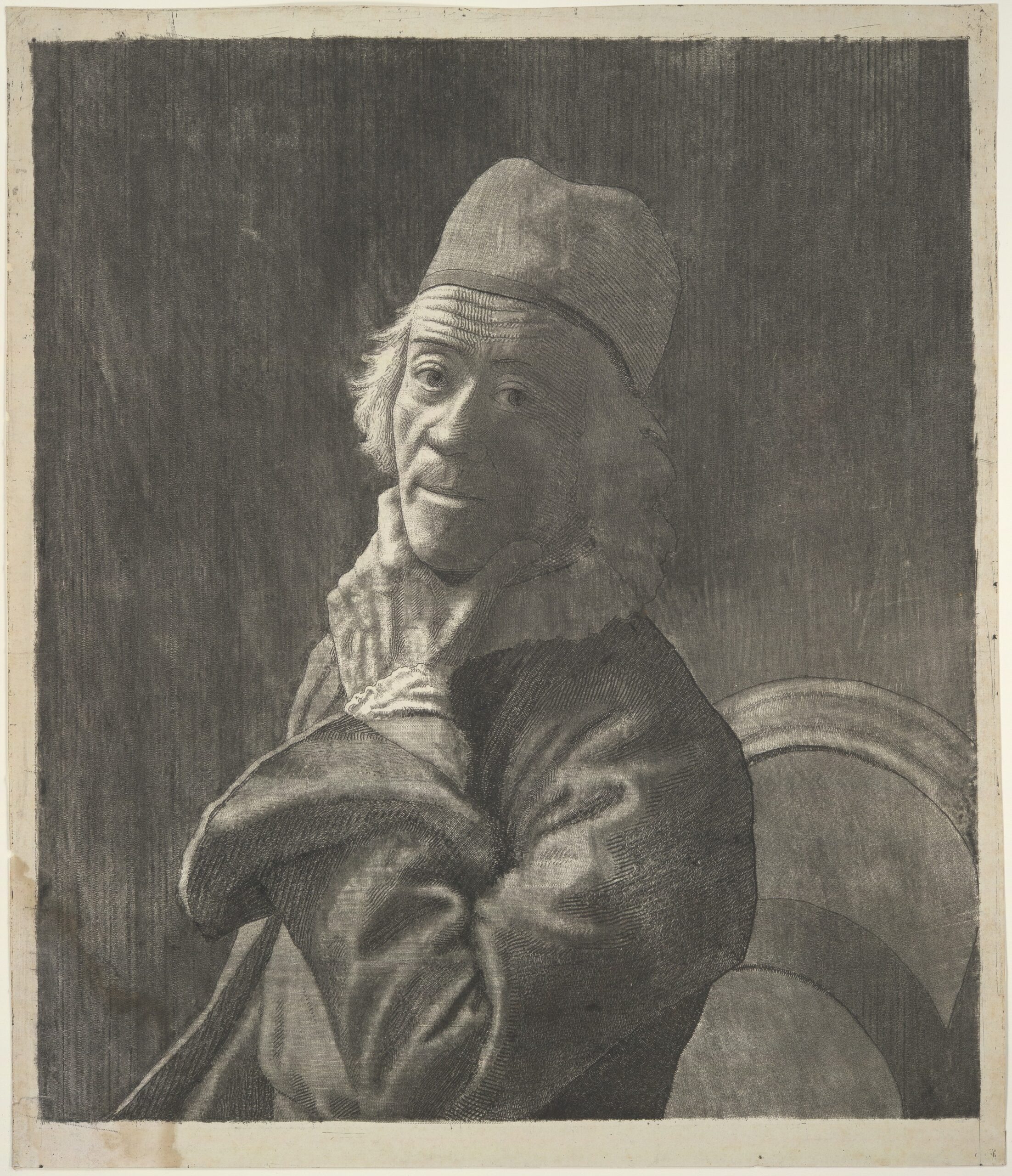
“Self-Portrait” is a mezzotint print on paper created by the Swiss artist Jean-Étienne Liotard in 1785. The work shows Liotard sitting in front of a plain background, dressed in Ottoman attire, with a turban on his head.
It was likely created to represent his appearance, skill, and personality. The painting is also notable for Liotard’s attire, which was unconventional for the time, reflecting his travels and interest in other cultures. It is currently located in the Musée d’Art et d’Histoire in Geneva, Switzerland.
Black Monday. or the Departure for School (William Redmore Bigg)
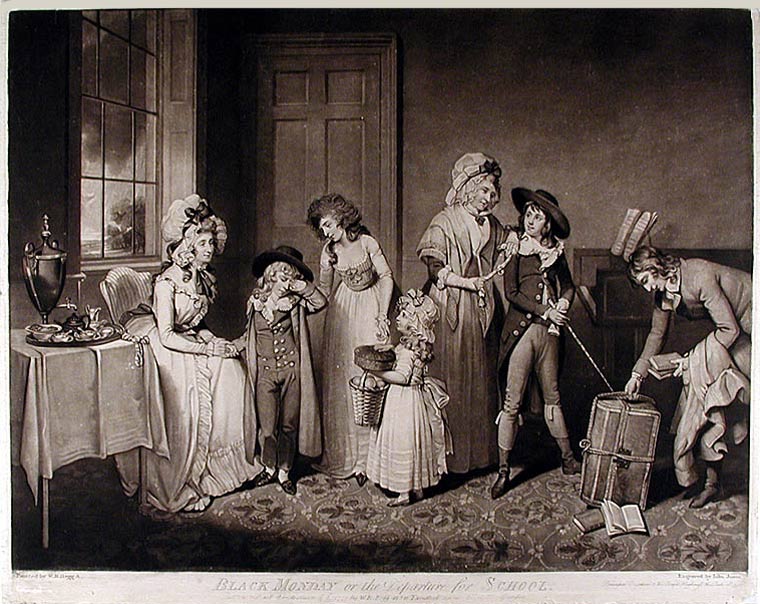
“Black Monday or the Departure for School,” by William Redmore Bigg and etched by John Jones in 1790, is a mezzotint hand-colored in watercolors and white pigment on slightly textured paper.
It depicts a large group of children leaving their homes to go to school on a Monday morning, with parents and caregivers bidding them farewell. It is currently located in the British Museum in London, UK.
A Visit to the Boarding School (George Morland, 1788)
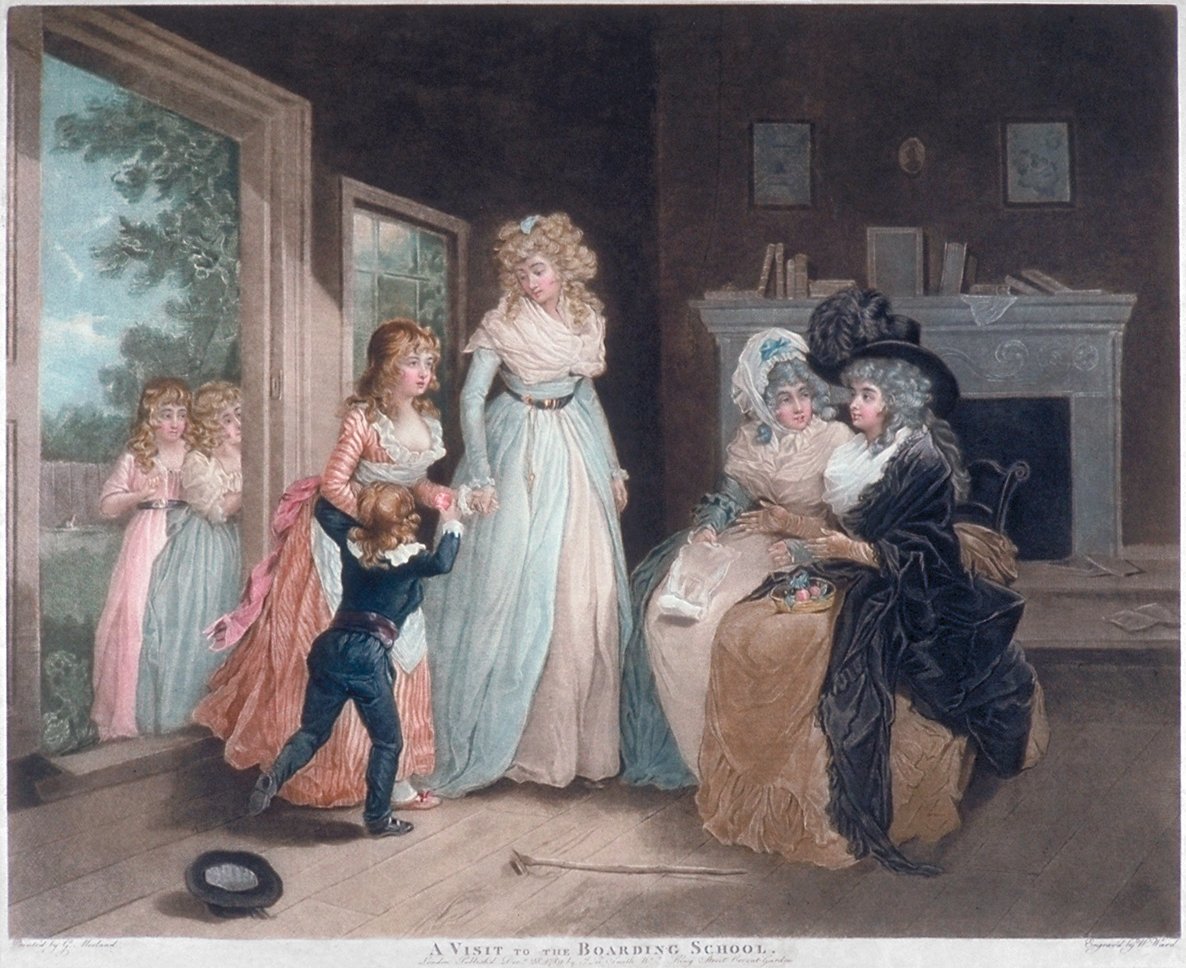
“A Visit to the Boarding School” is a color mezzotint artwork on paper created by George Morland in 1788. The print shows a group of people gathered in a room, the center of attention is the mother and her children.
The overall atmosphere of the image is one of warmth and care. It is currently located in London, UK, as part of The Wallace Collection.
Mezzotint Frequently Asked Questions (FAQs)
Here are some frequently asked questions about mezzotint printmaking.
What is the purpose of mezzotint?
Mezzotint was particularly popular in the seventeenth and eighteenth centuries for reproducing fine art and portrait prints. At the time, it was one of the few techniques that could produce a high tonal variation, allowing a more accurate representation of the original artwork.
Creating a mezzotint print is time-consuming, and printing often wears out the plates after a relatively small number of impressions. However, the final images are highly detailed and have a rich, velvety quality that is still highly prized today.
Artists widely use this technique to create a beautiful and detailed print which is usually used for reproducing paintings and drawings. In the eighteenth century, printers also used mezzotint prints to produce book illustrations and develop maps and architectural plans.
What is the difference between etching and mezzotint?
Etching and mezzotint are printmaking techniques used to create images on metal plates, but the method and the final result differ.
Etching creates an image by applying a protective coating, such as wax or varnish, to a metal plate, then using a needle or other sharp tool for drawing a line through the layer and into the plate.
The plate is then immersed in an acid bath, which eats away at the exposed metal, creating lines or areas of varying depth. The plate is then inked and pressed onto paper to make the final print. The final image has detailed lines, appearing more like a drawing.
On the other hand, mezzotint creates an image by scraping and burning a plate covered in a layer of fine metal burrs. The plate is then inked and wiped, and when the plate is pressed onto the paper, the scraped and burnished areas will not hold ink, resulting in a lighter area of the print.
The more the plate is scraped and burnished, the brighter it will be. The final image has a lot of soft gradations, and the image appears more like a painting.
In summary, etching uses acid and needles to create an image by biting into the metal plate, while mezzotint uses scraping and burnishing to create an image by removing metal particles. Etching is used for creating lines, and mezzotint is used for tonal variations.
What is the difference between aquatint and mezzotint?
Aquatint and mezzotint are printmaking techniques that create tonal variations in a print.
Aquatint creates tonal variations by etching a plate with a fine, granular substance called “aquatint dust” or “rosin.”
The plate is then immersed in an acid bath, which eats away at the parts of the plate not protected by the rosin. The deeper the etch, which makes the print areas darker, the longer the plate is in the acid.
On the other hand, mezzotint creates tonal variations by scraping and burning a mezzotint engraving that has been evenly covered in a layer of fine metal particles. The plate is then inked and wiped, and when the plate is pressed onto the paper, the scraped and burnished areas will not hold ink, resulting in a lighter area of the print.
How do you identify a mezzotint?
To spot a mezzotint, an art dealer will look at the characteristic fine, crosshatched lines in the various shades of grey. They are created by scraping an instrument with a toothed edge. These outlines may be seen on the print’s edges.
Plate markings and increased ink levels characteristic of an intaglio press will characterize the mezzotint. Extreme wear was expected with an early mezzotint plate. This allows for reprints to be significantly lighter.
